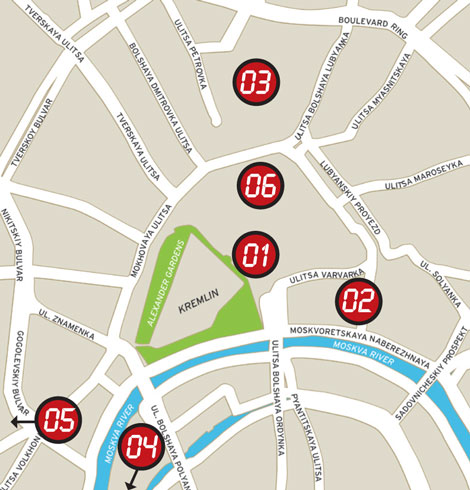Forget the bling, says Philip Parker, the real attraction in Moscow is its mad and magnificent history.

1. Red Square
Few cities can boast a central space as beautiful and redolent of history as Moscow’s Red Square, with architecture ranging from the onion domes of St Basil’s Cathedral to the sleek modernism of Lenin’s Mausoleum. Flanked on one side by the red crenellated walls of the Kremlin and on the other by the 19th-century GUM shopping arcades, Red Square is satisfyingly vast, its area accentuated by the slight curvature of its cobbled surface. There is no need to go inside any of the buildings on the square, although the shrunken corpse of the Father of the Revolution has a morbid fascination for some; instead, grab a coffee in the trendy Bosco Bar on the ground floor of GUM, which has a terrace out on the square.
2. Palace of the Romanov Boyars
Ulitsa Varvarka, south-east of Red Square, is Moscow’s oldest street and the only part of the historic Zaryadye district to have survived the 1960s construction of the Rossiya Hotel – which was in turn torn down in 2006 to make way for a Norman Foster development. Among several pretty buildings on Ulitsa Varvarka, the Palace of the Romanov Boyars at number ten is the highlight. Built in the 16th century for Nikita Romanov, brother-in-law of Ivan the Terrible, the palace was reconstructed in 1859, and the evocative interiors include beautiful embossed-leather wall hangings, tiled stoves, and intricate woodwork in the upstairs women’s quarters. Open Thurs-Mon 10am-6pm, Wed 11am-7pm.
3. Sandunovskiye Baths
Located just north of Moscow’s most fashionable shopping district around Kuznetskiy Most metro station, the Sanduny have been a city institution since the early 19th century, with former patrons including Tolstoy and Chekhov. The baths are divided by gender and by class, with the Men’s Higher Baths by far the most ornate (including a Roman-style plunge pool purportedly used by Sergei Eisenstein to film the storm scene in Battleship Potemkin). For the traditional Russian bath experience, don a sheet and felt hat, spend as long as you can bear in the scalding steam room while being gently whipped with birch twigs, and then dive into a freezing plunge pool before finishing off with a shot of vodka or an icy beer and a plate of zakuski – Russian drinking snacks – in one of the bathhouse bars or the upmarket Sanduny Restaurant. Open daily 8am-10pm. Visit sanduny.ru.
4. New Tretyakov Gallery
The State Tretyakov Gallery boasts the largest collection of Russian art in the world. Most of this is housed in the mansion in Zamoskvareche which founder Pavel Tretyakov gifted to the city, but those with less time on their hands should check out the 20th-century collection at the New Tretyakov on Krymsky Val next to Gorky Park. Alongside names like Kandinsky and Chagall, both of whom are well represented, high points include the work of constructivists and suprematists including Alexander Rodchenko, Vladimir Tatlin, and Kazimir Malevich, whose Black Square is probably the highlight of the collection. Open Tues-Sun 10am-7pm. Visit tretyakovgallery.ru.
5. Novodevichy Convent
About 15 minutes’ walk from the New Tretyakov on the opposite bank of the Moskva River, the Novodevichy Convent was founded in 1524 and was frequently used as a dumping ground for troublesome women, including Peter the Great’s half-sister and first wife. If you don’t have time to explore the convent itself, spend half an hour in the fascinating cemetery next door, which contains the graves of Chekhov, Bulgakov, Prokofiev, Shostakovich and Eisenstein, among others. The sheer variety of the headstones and tombs is the real attraction, though, with the decorations on the graves of Soviet dignitaries including tanks, space rockets and missiles.
6. The Metro
Moscow’s vast underground railway is probably the most beautiful in the world – if anything can make Stalin’s brutal industrial reforms seem beguiling, it must be the palatial decorations of the stations built either side of the Second World War, especially those on the Circle Line. If you’re following the route above, take a look at Ploshchad Revolyutsii (next to Red Square), which has a spectacular red marble central hall flanked with bronze statues of Red Army soldiers, and Park Kulturi, with its fine grey marble walls lined with rows of neo-classical bas-reliefs showing Soviet youth in a variety of athletic poses.








